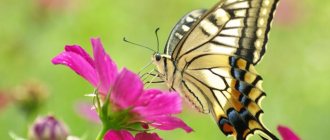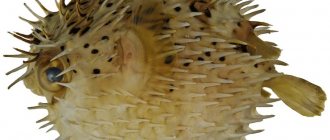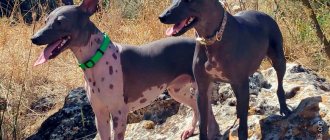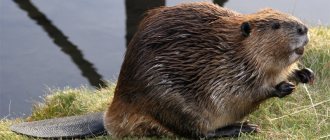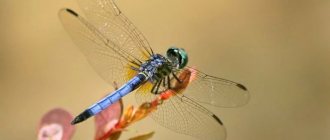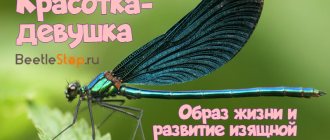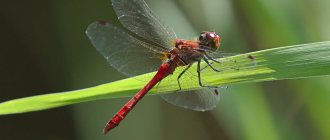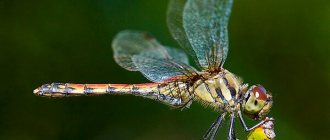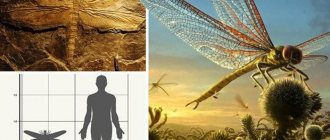Dragonfly interesting facts for children. Interesting facts about dragonflies
Dragonflies are relatively large flying insects. Dragonflies are active, specialized predators that feed on insects caught in flight. Widely distributed throughout the world, excluding Antarctica. Dragonflies lead an amphibiotic lifestyle - eggs and larvae develop in the aquatic environment, and adults (adults) live on land. Development with incomplete transformation: there are stages of egg, larva and adult. Dragonflies are of great importance to humans. Their role is great in regulating the number of blood-sucking insects and a number of insect pests of agriculture and forestry. Find out 35 interesting facts from the life of dragonflies...
The dragonfly has the most complex aircraft known to man. She has 2 pairs of wings, which she can control independently.
A dragonfly can fly forward, backward, sideways and hover in place.
In Feng Shui symbolism, the dragonfly signifies grace.
The dragonfly has six legs, but it cannot walk.
Dragonflies have up to 30 thousand facet eyes in each eye.
Dragonflies are very voracious - they can swallow 40 house flies whole in two hours!
Dragonflies are considered the fastest flying insects - they reach speeds of up to 60 km/h.
In Pennsylvania (USA) it was believed that dragonflies protected the home of snakes. If you kill such a dragonfly, a servant of a snake, then it may get angry and take revenge.
Scientists believe that dragonflies appeared about 350 million years ago.
The dragonfly emerges from the egg as a very small, wingless nymph, which, however, already has six legs, like an adult, fully developed dragonfly.
Known species
A short story about a dragonfly can include a description of different types of insects. Although they all form one unit, they are divided into suborders. The most interesting representatives of the family:
- the arrow is graceful;
- beauty girl;
- the lute is dull;
- ordinary grandfather;
- blood dragonfly;
- tramp redhead.
Every child in Europe has seen a dragonfly at least once in his life, which is called the graceful arrow. This is an insect with a long thin abdomen and transparent or dark gray wings. The rest of the body is colored blue, yellow-green or black.
The beauty girl grows up to 5 cm in length. These dragonflies have different colors depending on their gender. Males are bluish or green, while females have transparent wings with yellow veins and a pearlescent abdomen.
The dim lute is found in Eastern Europe. This insect has a yellow body with green spots. The common grandfather is distinguished by emerald eyes. The yellow chest is covered with black oblique stripes, the wings of the insect are transparent. This species lives in the Caucasus and Central Asia.
The blood dragonfly can be found in Europe and Africa. It received this name because of its color - its abdomen and wings are red. Rarely there are individuals with an orange or brown body. The insect has black dots on the sides, and the underside of the abdomen may be white.
The red-headed dragonfly also got its name because of its color - this dragonfly is golden-orange. It has an advantage over other species of its family: the insect flies quite high. It is found on all continents except Antarctica.
Dragonflies
Dragonflies (lat. Odonata) are very ancient insects and have many different nicknames, for example, “beauties”, “grandmothers”, “sky skates”, “devil’s needles” and so on, but perhaps the most poetic name of the insect is translated from Latin as: “born by the scent of the Universe.”
There are more than 6,650 species of these colorful, shiny-winged predators in the world, which can differ from each other in size, body color, shape and color of wings, flight style and lifestyle.
Moreover, the wingspan of the largest representatives of the species can reach twenty centimeters.
Over the long history of their development, dragonflies have adapted, with the help of serrated jaws, to catch and eat various small insects, snatching them right in the air. The victims of the insect are usually flies, mosquitoes, butterflies, and small midges. At the same time, the dragonfly's grasping front legs contribute to a strong grip on the prey and help to hold the captured trophy during flight. However, this form of limbs is absolutely not suitable for walking; therefore, in order to rest, the dragonfly is forced to cling to various supports, using small claws on its legs for this purpose.
Thanks to its movable head with huge faceted, convex eyes, the dragonfly has a very wide view and at the same time sees everything that happens in front, behind and to the sides (the number of small eyes isolated from each other can reach 30 thousand).
At the same time, according to scientists, the upper rows of eyes transmit a black and white image to the insect, and the lower rows provide a multicolored image. The fact is that such an unusual structure of the visual organs is due to the peculiarity of hunting, since the dragonfly perfectly sees its intended prey against the background of a bright sky, even in black and white. But to capture the prey, it has to attack from above, and in this case, color vision helps dragonflies quickly recognize the objects of hunting against the backdrop of the earth’s surface, full of colors. This vision device helps the dragonfly notice prey at a distance of up to 8 meters.
It is noteworthy that some varieties of dragonflies are capable of flying speeds of up to 57 (!) kilometers per hour.
During flight, the elongated shape of the insect's body acts as a kind of balancer. At the same time, certain species of dragonflies are capable of covering considerable distances; for example, there are known cases when they landed on the deck of ships two hundred miles from the nearest shore.
It is noteworthy that a dragonfly can not only suddenly sharply change the direction of its flight, making somersaults and dizzying turns at right angles, but has the ability to hover in the air and even fly tail first.
The benefits of dragonflies. Dragonflies can be beneficial
Who doesn’t know dragonflies, who hasn’t admired their flight? These amazing insects always attract our attention with the brilliance of their iridescent wings and bright body coloring.
And what unusual, often lyrical names people gave them: beauty girl, silver beauty, arrow girl, green grandmother, big rocker, watchman-emperor.
Characteristics
Dragonflies are one of the most ancient insects. They lived on our planet back in the Carboniferous period, i.e. more than 300 million years ago. Since then, their structure has not changed fundamentally. All dragonflies are characterized by a slender, elongated body and a large head, most of which is occupied by huge eyes. The two pairs of wings in all species are pierced by a dense network of small veins. Moreover, they are not always light; some of the dragonflies (for example, beauty ones) have blue wings. Most dragonflies fly during the day, most often near bodies of water. On the fly they catch their prey, mainly various mosquitoes. Their larvae live in water, where all dragonflies lay their eggs. They breathe with special gills, most often located at the end of the abdomen. In the larvae of large dragonflies, the gills are located in the hindgut, and respiration is carried out by “inhaling” and “exhaling” water through the anus. With a sharp “exhalation,” such larvae push forward, using a kind of “jet engine.” Dragonfly larvae are also predators, feeding mainly on the larvae of aquatic insects and other invertebrates. For “hunting” they use a huge lower lip, the so-called. mask, sharply throwing it forward and grabbing the prey. The last instar larvae, having completed their development, climb onto the stems of aquatic plants sticking out of the water, dry out and turn into adult dragonflies. This transformation may take several hours. First, the larva's body covers on the chest burst, and through the gap a whitish, at first seemingly unformed, body of the future adult insect appears. Then the wings gradually spread, the body becomes colored, and its covers harden. A fledged insect usually acquires the ability to fly confidently only the next day.
Body structure
The dragonfly is a type of amphibious insect that has adapted to life both in water and on land. But they are not found in countries with dry climates. But these beautiful creatures inhabit all continents except Antarctica.
Winged insects have several features in their body structure that set them apart from others:
- subtle body consisting of 11 segments;
- large head attached to the chest;
- two pairs of chitinous wings;
- elongated bright abdomen;
- six hard legs covered with hairs.
Insects can have almost any color: blue, yellow, green, dark blue, even white. Sometimes the abdomen is covered with spots or pearlescent chitin.
In the story about the dragonfly, you can briefly describe the structure of its eyes. They occupy three quarters of the head area, consist of 30,000 facets, each of them can be considered as a separate organ. All elements are placed in rows - some perceive the shape and volume of surrounding objects, others distinguish colors.
Additional eyes are located on the crown of the head in a triangle. Thanks to so many visual organs, a dragonfly can see 360 degrees around itself. At the same time, she does not need to constantly turn around. But other senses are poorly developed. Insects have no hearing, they only detect sound vibrations with special antennae, and there is almost no sense of smell.
